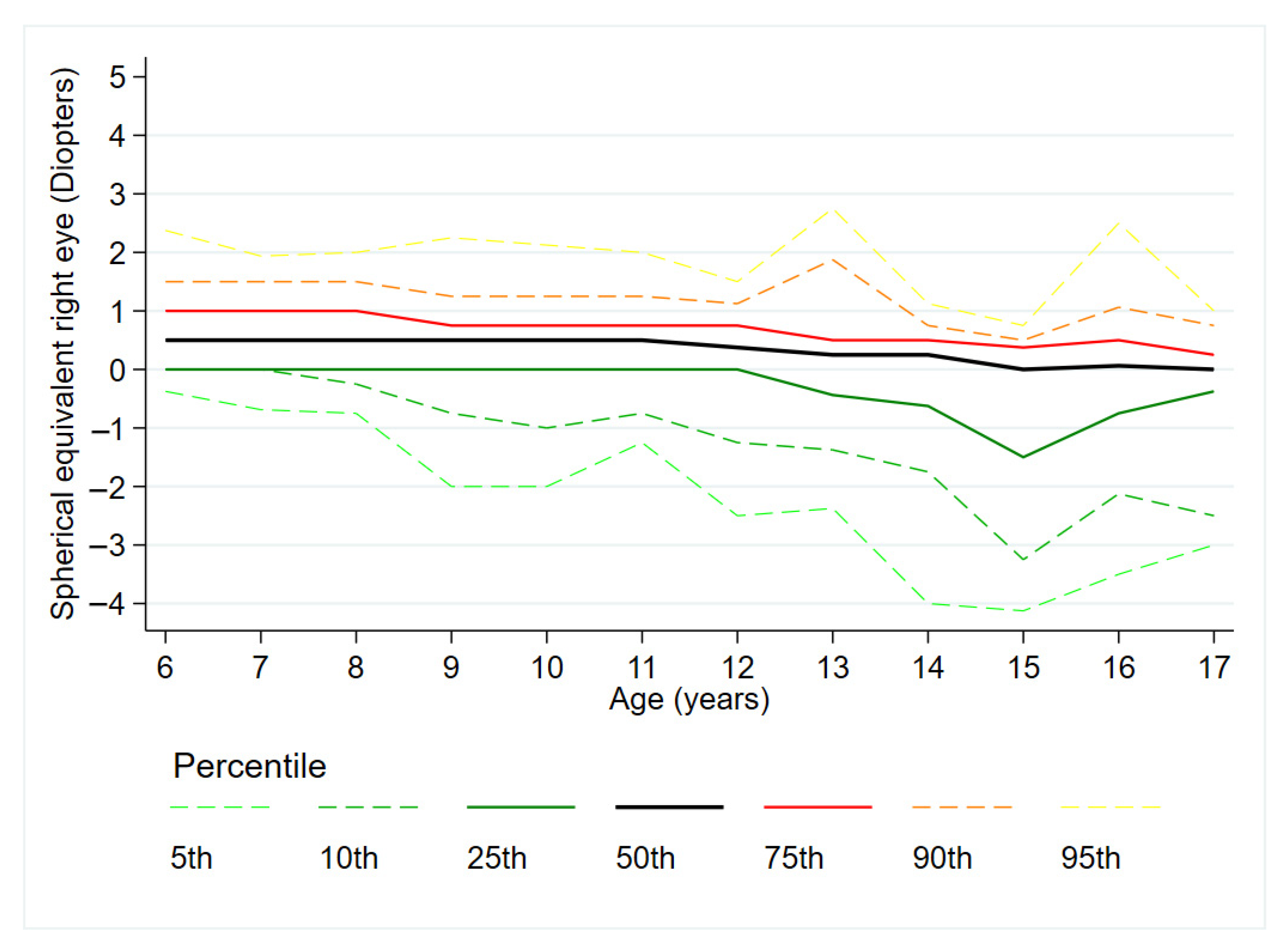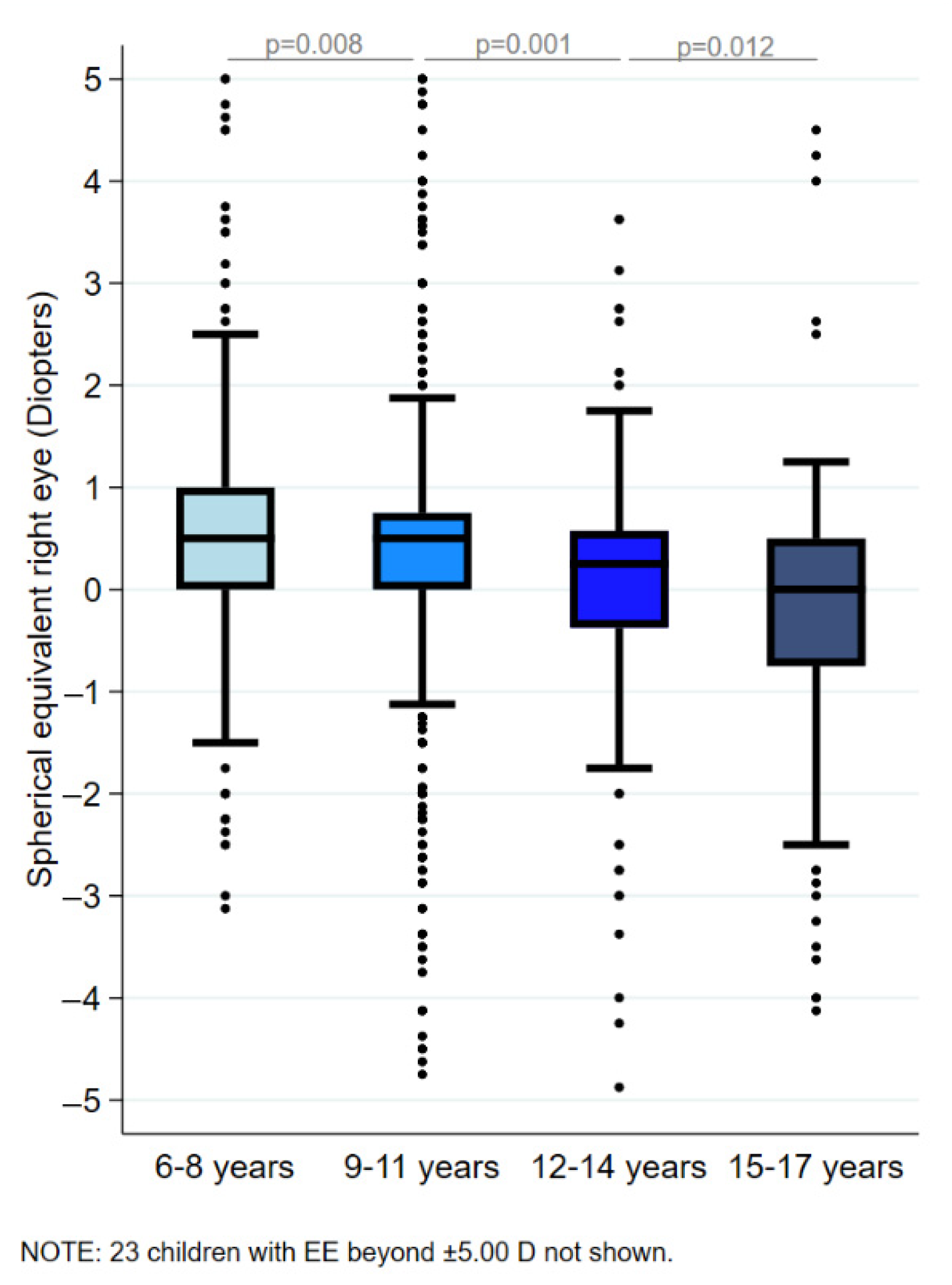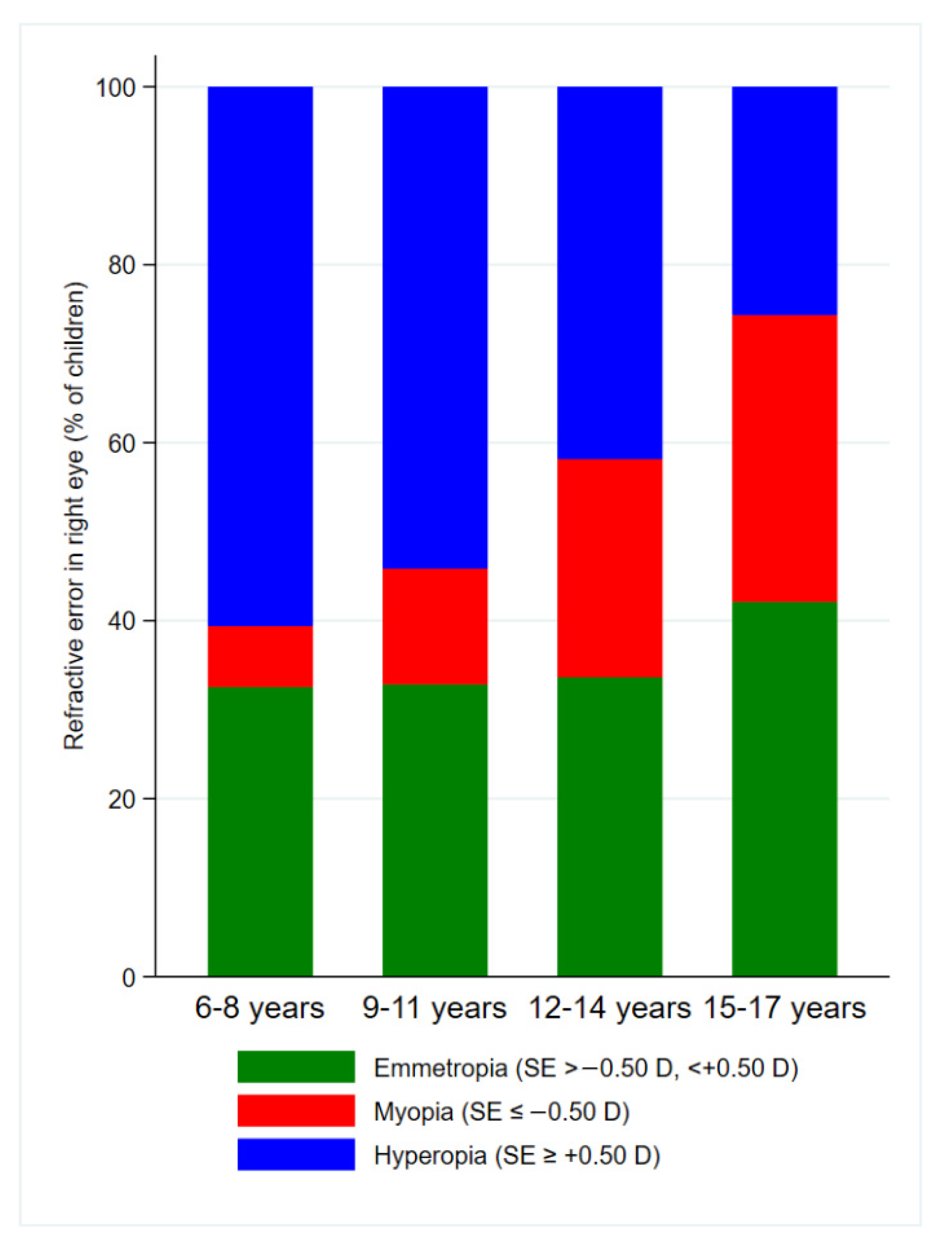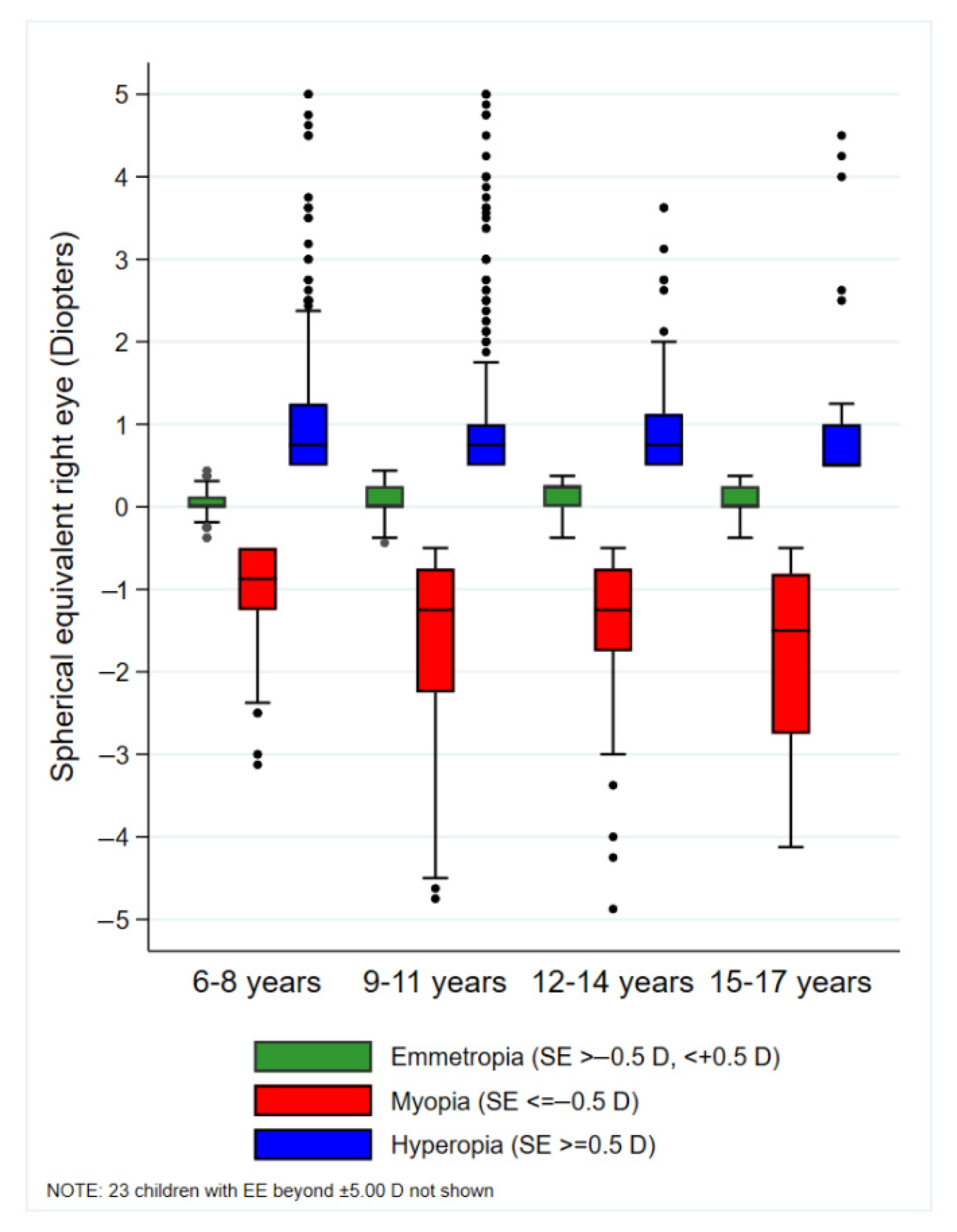Spherical Equivalent Percentile Curves in a Portuguese School-Aged Population
Abstract
1. Introduction
2. Materials and Methods
2.1. Study Design
2.2. Study Population
2.3. Procedure
- Myopia: SE ≤ −0.50 D;
- Hyperopia: SE ≥ +0.50 D;
- Emmetropia: SE between −0.50 D and +0.50 D;
- Astigmatism: Cylinder < 0.00 D (negative-cylinder notation).
2.4. Statistical Analysis
3. Results
4. Discussion
5. Conclusions
Supplementary Materials
Author Contributions
Funding
Institutional Review Board Statement
Informed Consent Statement
Data Availability Statement
Conflicts of Interest
References
- Sanz Diez, P.; Yang, L.; Lu, M.; Wahl, S.; Ohlendorf, A. Growth curves of myopia-related parameters to clinically monitor the refractive development in Chinese schoolchildren. Graefes Arch. Clin. Exp. Ophthalmol. 2019, 257, 1045–1053. [Google Scholar] [CrossRef]
- Rozema, J.; Dankert, S.; Iribarren, R. Emmetropization and nonmyopic eye growth. Surv. Ophthalmol. 2023, 68, 759–783. [Google Scholar] [CrossRef] [PubMed]
- Galvis, V.; Tello, A.; Camacho, P.A.; Parra, M.M.; Merayo-Lloves, J. Bio-environmental factors associated with myopia: An updated review. Arch. Soc. Esp. Oftalmol. 2017, 92, 307–325. [Google Scholar] [CrossRef] [PubMed]
- He, X.; Sankaridurg, P.; Naduvilath, T.; Wang, J.; Xiong, S.; Weng, R.; Du, L.; Chen, J.; Zou, H.; Xu, X. Normative data and percentile curves for axial length and axial length/corneal curvature in Chinese children and adolescents aged 4–18 years. Br. J. Ophthalmol. 2023, 107, 167–175. [Google Scholar] [CrossRef] [PubMed]
- Flitcroft, D.I. Emmetropisation and the aetiology of refractive errors. Eye 2014, 28, 169–179. [Google Scholar] [CrossRef]
- Guo, X.; Fu, M.; Lü, J.; Chen, Q.; Zeng, Y.; Ding, X.; Morgan, I.G.; He, M. Normative distribution of visual acuity in 3- to 6-year-old Chinese preschoolers: The Shenzhen kindergarten eye study. Investig. Ophthalmol. Vis. Sci. 2015, 56, 1985–1992. [Google Scholar] [CrossRef]
- González-Jiménez, R.; Povedano-Montero, F.J.; Bernárdez-Vilaboa, R.; Gomez-de-Liano, R.; Guemes-Villahoz, N.; Cedrún-Sánchez, J.E. The Distribution of Ocular Normative Parameters in a Spanish School Population. J. Clin. Med. 2025, 14, 2507. [Google Scholar] [CrossRef]
- Liang, J.; Pu, Y.; Chen, J.; Liu, M.; Ouyang, B.; Jin, Z.; Ge, W.; Wu, Z.; Yang, X.; Qin, C.; et al. Global prevalence, trend and projection of myopia in children and adolescents from 1990 to 2050: A comprehensive systematic review and meta-analysis. Br. J. Ophthalmol. 2025, 109, 362–371. [Google Scholar] [CrossRef]
- Alves Carneiro, V.L.; González-Méijome, J.M. Prevalence of refractive error in Portugal—A systematic review and meta-analysis. J. Optom. 2023, 16, 182–188. [Google Scholar] [CrossRef]
- Borghi, E.; de Onis, M.; Garza, C.; Van den Broeck, J.; Frongillo, E.A.; Grummer-Strawn, L.; van Buuren, S.; Pan, H.; Molinari, L.; Martorell, R.; et al. Construction of the World Health Organization child growth standards: Selection of methods for attained growth curves. Stat. Med. 2006, 25, 247–265. [Google Scholar] [CrossRef]
- Chen, Y.; Zhang, J.; Morgan, I.G.; He, M. Identifying Children at Risk of High Myopia Using Population Centile Curves of Refraction. PLoS ONE 2016, 11, e0167642. [Google Scholar] [CrossRef]
- Truckenbrod, C.; Meigen, C.; Brandt, M.; Vogel, M.; Wahl, S.; Jurkutat, A.; Kiess, W. Reference curves for refraction in a German cohort of healthy children and adolescents. PLoS ONE 2020, 15, e0230291. [Google Scholar] [CrossRef]
- Tang, Y.; Chen, A.; Zou, M.; Liu, Z.; Young, C.A.; Zheng, D.; Jin, G. Prevalence and time trends of refractive error in Chinese children: A systematic review and meta-analysis. J. Glob. Health 2021, 11, 08006. [Google Scholar] [CrossRef] [PubMed]
- Peng, L.; Gao, L.; Zheng, Y.; Dai, Y.; Xie, Q. Refractive errors and visual impairment among children and adolescents in southernmost China. BMC Ophthalmol. 2021, 21, 227. [Google Scholar] [CrossRef] [PubMed]
- Zhang, X.; Wang, Y.; Huang, D.; Sun, Q.; Zhao, X.; Ding, H.; Bai, J.; Chen, J.; Chen, X.; Liu, H. Prevalence of reduced visual acuity among preschool children in eastern China and comparison at a 5-year interval. Clin. Exp. Ophthalmol. 2018, 46, 994–1001. [Google Scholar] [CrossRef] [PubMed]
- Chen, J.; Liu, S.; Zhu, Z.; Bulloch, G.; Naduvilath, T.; Wang, J.; Du, L.; Yang, J.; Zhang, B.; Zou, H.; et al. Axial length changes in progressive and non-progressive myopic children in China. Graefes Arch. Clin. Exp. Ophthalmol. 2023, 261, 1493–1501. [Google Scholar] [CrossRef]
- Mu, J.; Zeng, D.; Fan, J.; Liu, M.; Zhong, H.; Shuai, X.; Zhang, S. The accuracy of the axial length and axial length/corneal radius ratio for myopia assessment among Chinese children. Front. Pediatr. 2022, 10, 859944. [Google Scholar] [CrossRef]
- Sankaridurg, P.; Naduvilath, T.; He, X.; Zhu, J.; Zou, H.; Xu, X. Axial length and Axial length/Corneal Curvature percentiles for Chinese cohort aged 4 to 18 years. Investig. Ophthalmol. Vis. Sci. 2020, 61, 2689. [Google Scholar]
- Tideman, J.W.L.; Polling, J.R.; Vingerling, J.R.; Jaddoe, V.W.V.; Williams, C.; Guggenheim, J.A.; Klaver, C.C.W. Axial length growth and the risk of developing myopia in European children. Acta Ophthalmol. 2018, 96, 301–309. [Google Scholar] [CrossRef]
- Harrington, S.C.; O’Dwyer, V. Ocular biometry, refraction and time spent outdoors during daylight in Irish schoolchildren. Clin. Exp. Optom. 2020, 103, 167–176. [Google Scholar] [CrossRef]
- Nunes, A.F.; Sena, F.; Calado, R.; Tuna, A.R.R.; Gonçalves, A.P.R.; Monteiro, P.L. Reduced visual acuity in children from 5 to 6 years old, with LEA chart. Graefes Arch. Clin. Exp. Ophthalmol. 2021, 259, 759–768. [Google Scholar] [CrossRef]
- Martínez-Pérez, C.; Pérez-Sánchez, B.; Villa-Collar, C. Percentile curves of refractive errors in a Spanish paediatric population. J. Optom. 2023, 16, 175–181. [Google Scholar] [CrossRef] [PubMed]
- Enaholo, E.S.; Musa, M.J.; Zeppieri, M. Objective Refraction Technique: Retinoscopy. In StatPearls; StatPearls Publishing: Treasure Island, FL, USA, 2025. [Google Scholar] [PubMed]
- Sankaridurg, P.; Berntsen, D.A.; Bullimore, M.A.; Cho, P.; Flitcroft, I.; Gawne, T.J.; Gifford, K.L.; Jong, M.; Kang, P.; Ostrin, L.A.; et al. IMI 2023 Digest. Investig. Ophthalmol. Vis. Sci. 2023, 64, 7. [Google Scholar] [CrossRef] [PubMed]
- Luong, T.Q.; Shu, Y.; Modjtahedi, B.S.; Fong, D.S.; Choudry, N.; Tanaka, Y.; Nau, C.L. Racial and Ethnic Differences in Myopia Progression in a Large, Diverse Cohort of Pediatric Patients. Investig. Ophthalmol. Vis. Sci. 2020, 61, 20. [Google Scholar] [CrossRef] [PubMed]
- Omar, R.; Wan Abdul, W.M.H.; Knight, V.F. Status of visual impairment among indigenous (Orang Asli) school children in Malaysia. BMC Public Health 2019, 19 (Suppl. 4), 543. [Google Scholar] [CrossRef]
- Lira, R.P.C.; Arieta, C.E.L.; Passos, T.H.M.; Maziero, D.; Astur, G.L.V.; do Espírito Santo, Í.F.; de Castro, R.S.; Ferraz, Á.A.B. Distribution of Ocular Component Measures and Refraction in Brazilian School Children. Ophthalmic Epidemiol. 2017, 24, 29–35. [Google Scholar] [CrossRef]
- Gao, F.; Guo, Q.; Wang, B.; Cao, S.; Qin, N.; Zhao, L.; Jia, C.; Duan, X. Distributions and determinants of time spent outdoors among school-age children in China. J. Expo Sci. Environ. Epidemiol. 2022, 32, 223–231. [Google Scholar] [CrossRef]
- Friedman, D.S.; Repka, M.X.; Katz, J.; Giordano, L.; Ibironke, J.; Hawes, P.; Burkom, D.; Tielsch, J.M. Prevalence of decreased visual acuity among preschool-aged children in an American urban population: The Baltimore Pediatric Eye Disease Study, methods, and results. Ophthalmology 2008, 115, 1786–1794. [Google Scholar] [CrossRef]
- Darge, H.F.; Shibru, G.; Mulugeta, A.; Dagnachew, Y.M. The Prevalence of Visual Acuity Impairment among School Children at Arada Subcity Primary Schools in Addis Ababa, Ethiopia. J. Ophthalmol. 2017, 2017, 9326108. [Google Scholar] [CrossRef]
- Becker, T.O.F.; Cortela, D.C.B.; Miura, H.; Matsuhara, M.L. Evaluation of visual acuity in municipal elementary school students. Rev. Bras. Oftalmol. 2019, 78, 37–41. [Google Scholar] [CrossRef]
- Ferede, A.T.; Alemu, D.S.; Gudeta, A.D.; Alemu, H.W.; Melese, M.A. Visual Impairment among Primary School Children in Gondar Town, Northwest Ethiopia. J. Ophthalmol. 2020, 2020, 6934013. [Google Scholar] [CrossRef]
- Talebnejad, M.R.; Khalili, M.R.; Tajbakhsh, Z.; Masoumpour, M.B.; Mahdaviazad, H.; Mohammadi, E.; Keshtkar, M.; Nowroozzadeh, M.H. The Prevalence and Causes of Low Vision and Visual Impairment in School-Aged Children: The Shiraz Pediatric Eye Study. J. Curr. Ophthalmol. 2022, 34, 333–340. [Google Scholar] [CrossRef]
- Azizoğlu, S.; Crewther, S.G.; Şerefhan, F.; Barutchu, A.; Göker, S.; Junghans, B.M. Evidence for the need for vision screening of school children in Turkey. BMC Ophthalmol. 2017, 17, 230. [Google Scholar] [CrossRef]
- Mutti, D.O.; Sinnott, L.T.; Mitchell, G.L.; Jordan, L.A.; Friedman, N.E.; Frane, S.L.; Lin, W.K.O. Ocular Component Development during Infancy and Early Childhood. Optom. Vis. Sci. 2018, 95, 976–985. [Google Scholar] [CrossRef] [PubMed]
- ECOO. European Council of Optometry and Optics. PhysicsWeb. Available online: https://ecoo.info/ecoo-blue-book/ (accessed on 21 July 2025).
- Doyle, L.A.; McCullough, S.J.; Saunders, K.J. Cycloplegia and spectacle prescribing in children: Attitudes of UK optometrists. Ophthalmic Physiol. Opt. 2019, 39, 148–161. [Google Scholar] [CrossRef] [PubMed]
- American Optometric Association. Comprehensive Pediatric Eye and Vision Examination: Evidence-Based Clinical Practice Guideline. PhysicsWeb. Available online: https://www.aoa.org/practice/clinical-guidelines/clinical-practice-guidelines (accessed on 21 July 2025).
- Khurana, A.K. Theory and Practice of Optics and Refraction, 5th ed.; Elsevier Health Sciences: Gurgaon, India, 2022. [Google Scholar]
- Benjamin, W.J. Borish’s Clinical Refraction, 2nd ed.; Butterworth-Heinemann: Amsterdam, The Netherlands, 2006. [Google Scholar]
- Morales Ruiz, H.; Fernández-Agrafojo, D.; Cardona, G. Correlation and agreement between the Mohindra and cycloplegic retinoscopy techniques in children. Arch. Soc. Esp. Oftalmol. 2022, 97, 9–16. [Google Scholar] [CrossRef]
- Kauser, F.; Gupta, Y.; Amitava, A.K.; Saxena, J.; Raza, S.A.; Masood, A.; Alam, M. Do all children need a cycloplegic refraction? A comparison of Mohindra’s versus cycloplegic refraction. Indian J. Ophthalmol. 2020, 68, 2458–2461. [Google Scholar] [CrossRef]
- Galvis, V.; Tello, A.; Otero, J.; Serrano, A.A.; Gómez, L.M.; Castellanos, Y. Refractive errors in children and adolescents in Bucaramanga (Colombia). Arq Bras. Oftalmol. 2017, 80, 359–363. [Google Scholar] [CrossRef] [PubMed]
- Grzybowski, A.; Kanclerz, P.; Tsubota, K.; Lanca, C.; Saw, S. A review on the epidemiology of myopia in school children worldwide. BMC Ophthalmol. 2020, 20, 27. [Google Scholar] [CrossRef]
- Morgan, I.G.; Wu, P.; Ostrin, L.A.; Tideman, J.W.L.; Yam, J.C.; Lan, W.; Baraas, R.C.; He, X.; Sankaridurg, P.; Saw, S.-M.; et al. IMI Risk Factors for Myopia. Investig. Ophthalmol. Vis. Sci. 2021, 62, 3. [Google Scholar] [CrossRef]
- Gopalakrishnan, A.; Hussaindeen, J.R.; Chaudhary, R.; Ramakrishnan, B.; Arunachalam, S.; Balakrishnan, A.C.; S, D.S.J.; Sahoo, M.; S, R.; M, V.; et al. Results of the School Children Ocular Biometry and Refractive Error Study in South India. Turk J. Ophthalmol. 2022, 52, 412–420. [Google Scholar] [CrossRef] [PubMed]
- Al-Salem, K.M.; Saleem, M.S.; Ereifej, I.; Alrawashdeh, H.M.; Obeidat, R.F.H.; Abdlmohdi, A.A.; Al-Momani, R.Z.; Hammad, L.M.; Al-Habahbeh, O.A.; Assassfeh, Y.M.; et al. Amblyopia screening for first and second-grade children in Jordan. Int. J. Ophthalmol. 2022, 15, 352–356. [Google Scholar] [CrossRef] [PubMed]
- Chew, F.L.M.; Thavaratnam, L.K.; Shukor, I.N.C.; Ramasamy, S.; Rahmat, J.; Reidpath, D.D.; Allotey, P.; Alagaratnam, J. Visual impairment and amblyopia in Malaysian pre-school children—The SEGPAEDS study. Med. J. Malaysia 2018, 73, 25–30. [Google Scholar] [PubMed]
- Ojaimi, E.; Rose, K.A.; Morgan, I.G.; Smith, W.; Martin, F.J.; Kifley, A.; Robaei, D.; Mitchell, P. Distribution of ocular biometric parameters and refraction in a population-based study of Australian children. Investig. Ophthalmol. Vis. Sci. 2005, 46, 2748–2754. [Google Scholar] [CrossRef]
- Li, S.M.; Li, S.Y.; Kang, M.; Zhou, Y.; Li, H.; Liu, L.; Yang, X.-Y.; Wang, Y.-P.; Yang, Z.; Zhan, S.-Y.; et al. Distribution of ocular biometry in 7- and 14-year-old Chinese children. Optom. Vis. Sci. 2015, 92, 566–572. [Google Scholar] [CrossRef]
- Kim, D.H.; Lim, H.T. Myopia Growth Chart Based on a Population-Based Survey (KNHANES IV-V): A Novel Prediction Model of Myopic Progression in Childhood. J. Pediatr. Ophthalmol. Strabismus 2019, 56, 73–77. [Google Scholar] [CrossRef]
- García Aguado, J.; Sánchez Ruiz-Cabello, F.J.; Colomer Revuelta, J.; Cortés Rico, O.; Esparza Olcina, M.J.; Galbe Sánchez-Ventura, J.; M Mengual Gil, J.; Merino Moína, M.; Rosa Pallás Alonso, C.; Martínez Rubio, A.; et al. Valoración de la agudeza visual. Rev. Pediatr. Aten. Primaria 2016, 18, 267–274. [Google Scholar]




| Total (n = 2205) | Boys (n = 1087; 49.3%) | Girls (n = 1118; 50.7%) | |
| Age (mean ± SD) | 9.33 ± 2.56 | 9.36 ± 2.50 | 9.30 ± 2.62 |
| Age category (n, (%)) | |||
| 6–8 years | 921 (41.77) | 442 (40.66) | 479 (42.84) |
| 9–11 years | 955 (43.31) | 479 (44.07) | 476 (42.58) |
| 12–14 years | 208 (9.43) | 113 (10.40) | 95 (8.50) |
| 15–17 years | 121 (5.49) | 53 (4.88) | 68 (6.08) |
| Mean | SD | p25 | p50 | p75 | |
| Sphere (D) | |||||
| 6–8 years | 0.72 | 1.15 | 0.00 | 0.50 | 1.00 |
| 9–11 years | 0.70 | 1.50 | 0.25 | 0.50 | 1.00 |
| 12–14 years | 0.28 | 1.31 | 0.00 | 0.50 | 0.75 |
| 15–17 years | −0.18 | 1.75 | −0.50 | 0.00 | 0.50 |
| Cylinder (D) | |||||
| 6–8 years | −0.30 | 0.77 | −0.25 | 0.00 | 0.00 |
| 9–11 years | −0.48 | 0.79 | −0.50 | −0.25 | 0.00 |
| 12–14 years | −0.48 | 0.75 | −0.50 | −0.25 | 0.00 |
| 15–17 years | −0.45 | 0.72 | −0.50 | −0.13 | 0.00 |
| Spherical Equivalent (D) | |||||
| 6–8 years | 0.59 | 1.05 | 0.00 | 0.50 | 1.00 |
| 9–11 years | 0.40 | 1.33 | 0.00 | 0.50 | 0.75 |
| 12–14 years | 0.05 | 1.38 | −0.38 | 0.25 | 0.54 |
| 15–17 years | −0.40 | 1.77 | −0.75 | 0.00 | 0.50 |
Disclaimer/Publisher’s Note: The statements, opinions and data contained in all publications are solely those of the individual author(s) and contributor(s) and not of MDPI and/or the editor(s). MDPI and/or the editor(s) disclaim responsibility for any injury to people or property resulting from any ideas, methods, instructions or products referred to in the content. |
© 2025 by the authors. Licensee MDPI, Basel, Switzerland. This article is an open access article distributed under the terms and conditions of the Creative Commons Attribution (CC BY) license (https://creativecommons.org/licenses/by/4.0/).
Share and Cite
Peñaloza-Barbosa, M.I.; Martinez-Perez, C.; Andreu-Vázquez, C.; Sánchez-Tena, M.Á.; Alvarez-Peregrina, C. Spherical Equivalent Percentile Curves in a Portuguese School-Aged Population. J. Clin. Med. 2025, 14, 7262. https://doi.org/10.3390/jcm14207262
Peñaloza-Barbosa MI, Martinez-Perez C, Andreu-Vázquez C, Sánchez-Tena MÁ, Alvarez-Peregrina C. Spherical Equivalent Percentile Curves in a Portuguese School-Aged Population. Journal of Clinical Medicine. 2025; 14(20):7262. https://doi.org/10.3390/jcm14207262
Chicago/Turabian StylePeñaloza-Barbosa, María Ibeth, Clara Martinez-Perez, Cristina Andreu-Vázquez, Miguel Ángel Sánchez-Tena, and Cristina Alvarez-Peregrina. 2025. "Spherical Equivalent Percentile Curves in a Portuguese School-Aged Population" Journal of Clinical Medicine 14, no. 20: 7262. https://doi.org/10.3390/jcm14207262
APA StylePeñaloza-Barbosa, M. I., Martinez-Perez, C., Andreu-Vázquez, C., Sánchez-Tena, M. Á., & Alvarez-Peregrina, C. (2025). Spherical Equivalent Percentile Curves in a Portuguese School-Aged Population. Journal of Clinical Medicine, 14(20), 7262. https://doi.org/10.3390/jcm14207262








